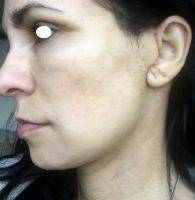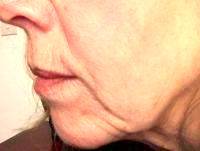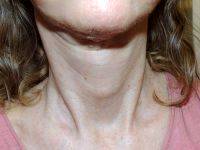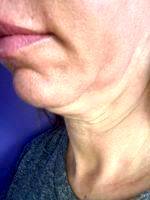Should I Get A Facelift At 40?
Although 40 might sound young for a “face lift” – for some patients it is the correct procedure.
Everyone ages at a different rate, and different parts of the face may age faster or slower.
Some patients would benefit from full facial rejuvenation (face, eyes, and brow), while others only need the brow, and some just need the lower face addressed.
It is not uncommon these days to have a patient who was heavy for a period of time, and now successfully reset their weight-point at a much lower weight.
For these patients, the skin deflation and loss of elasticity results in the appearance of premature aging.
Then again, some people just are genetically pre-disposed to the appearance of aging.

Counteract Sagging Skin Around The Face
Visit with a board certified surgeon who offers all of the procedures you have been considering (resurfacing, fillers, fat grafting, face lift), and ask them their thoughts about short vs long-term fixes, and their opinion regarding the optimum treatment plan. (Michael A. Bogdan, MD, FACS, Dallas Plastic Surgeon)
Forty is on the younger end of the spectrum for this surgery. However, we all age differently and certainly our expectations/preferences for our appearance also vary.
Typically, if genetic factors conspire to make us develop jowls or neck skin laxity at a younger age, and if this is visible and bothersome, an experienced surgeon may evaluate you and agree that surgery is an option.

Early Ageing Of The Face
No set age for a face lift
There is no set age for a face lift. A face lift is indicated when the patient wnts to remedy the signs of aging. Deep nasolabial gold perioral lines, jowles, and neck lines. We age at different pace.
If you are aging at 40 then you need a face lift if you want to reverse the signs of aging. (Samir Shureih, MD, Baltimore Plastic Surgeon)
No, but you probably won’t benefit enough to make it worthwhile
There is no absolute age range for facelfits. In my practice women start seeking surgery around the mid forties while men the mid fifties. My job is to appraise the cost/benefits for the patients.

Facelift 40 Years
They can make a younger patient look older but they are really not a phenomenon of aging. (Vincent N. Zubowicz, MD, Atlanta Plastic Surgeon)
It is not uncommon to show dramatic sings of aging after significant weight loss. This is due to loss of facial fat and decreasing health of the skin.
If you have significant skin, a descending neck and jowling than you may be in need of a facelift. If not than fillers, perhaps even fat injections, maybe Botox and a good skin care program including peels is a good way to go. (Christopher L. Hess, MD, Fairfax Plastic Surgeon)

Facelift At 40 Years Old
Determining the right age for a Facelift
Evaluating overall skin laxity, evidence of jowls, midfacial descent and neck elevation can help determine candidacy for one or another facelift or approach to facial rejuvenation. Loss of volume in the midface causing perioral lines and hollowing can definitely be an indicator of the need for a facelift or midface lift.
The ultimate question we ask patients with similar concerns as yours is, what are your concerns and what are you looking to achieve? When considering surgical verses non-surgical treatments, patients must weigh out the cost, efficacy and results of various procedures and determine the plan that best treats their concerns within their budget. (Richard A. Zoumalan, MD, Beverly Hills Facial Plastic Surgeon)
Everybody has different anatomy, and everybody’s skin ages differently. There are some disorders that result in rapidly aging skin, and this may necessitate a facelift at a young age.

Facelift For 40 Year Old
When we assess our patients for facial rejuvenation procedures we don’t make decisions based on age alone, as everyone ages differently. On this basis, there is no cut off age that is right to perform a facelift – it is only determined after a consultation and assessment by a properly accredited and experienced plastic surgeon.
I would suggest seeing an experienced plastic surgeon who can assess you in person and give you the best advice for you personally. (Marc Pacifico, MD, FRCS(Plast), London Plastic Surgeon)

Lower Facelift At 40
The short answer: 40 is not too young for a facelift. If your jowls and skin excess in your neck region are bothering you, then a facelift is the way to improve them. Facelift and fillers do different things, and they should not be regarded as interchangeable.
Fillers are for volume replacement and are the best treatment for nasolabial folds and marionette lines, as well as lost volume in the cheeks. Facelifts will elevate the jowls and tighten the neck, but it will probably have a minimal effect on the nasolabial folds, marionette lines, and cheek volume.
It is important to not confuse the two. The best is to do both: A lift will address the sagging excess skin, and fillers will replenish the volume loss that occurs as we age. (Louis C. Cutolo, Jr., MD, FACS, New York Plastic Surgeon)

The Average 40 Year-old Of Today Looks Much Younger
By this, I am referring to the sagging of the upper cheek and the puffy eyes. For this particular issue I recommend the upper and lower eyelid surgery and a subperiosteal mid-facelift (also called a cheek lift.)
Typically adding your fat, by placing micro-droplets of fat in the areas of the face that have had loss of volume. To enhance the fat survival I am adding Platelet Rich Plasma to the fat at the time of injection.
Another alternative to the upper central face is doing the upper eyelid surgery combined with an extended lower eyelid procedure that lifts the cheek off the rim of the lower eyelid to allow some lift of the upper cheek.

When To Consider A Facelift
When the jowls and the neck are also a problem then I combine the subperiosteal mid-facelift with the SMAS facelift and fat injections to maximize rejuvenation of the entire face.
Depending on the aging of the brow, the brow can be lifted. The aging process has different presentations, therefore individualizing the face rejuvenation is very important for each patient. (David M. Creech, MD, Chandler Plastic Surgeon)
Best age for a facelift
You’ve heard it said that age is just a number, and that’s true for facelifts, as well. If a 40-year-old has areas that would be helped by a facelift, then a facelift is a fine treatment.

Are You Around The Age Of 40 And Considering A Facelift
Ask your surgeon about fat grafting, which can also be performed as part of a facelift. (Ross Blagg, MD, Austin Physician)
“Too Young” Is Subjective When Considering a Facelift
Most plastic surgeons today will tell you that there is no ideal age for facelift surgery. Everyone is different, and thanks to variations in genetics and lifestyle factors, we all age at different rates and in different ways.
Although I can’t offer a specific recommendation to you without an in-person consultation or a photo, it’s possible that you are indeed ready for facelift surgery now.
Keep in mind that although a facelift procedure will reposition soft tissues, it will not add fat where it was lost through aging; therefore, fat grafting might be recommended in addition to your facelift to fill the hollows around your cheeks and eyes. (Marc DuPéré, MD, Toronto Plastic Surgeon)
Facial aging changes start to become noticeable in the late 30’s for most people. In the process of aging the skin folds and loss of facial volume cause deep furrows and facial lines.
By the age of 55 -60 years they are permanent changes already, that are difficult to correct with a facelift alone.

Facelifts Themselves Have Changed Rather Dramatically Over The Years
They are more healthy than people over 60, and recover more easily. (Ercan Karacaoglu, MD, Turkey Plastic Surgeon)
Forty is fairly young to consider a facelift however it may be appropriate under certain circumstances. You may be surprised how beneficial some of the longer duration fillers can be in rejuvenating your face so be open-minded.
Over the years, I have performed facelifts on patients from the late 30’s to the mid 80’s. I do not believe that a patient’s specific age plays a significant role in aesthetic surgical decision-making because the physiologic and anatomic changes that create an “aged” facial appearance occur very differently from patient to patient.

Is 40 Too Young For Facelift
Also, many traditional procedures(facelift) have been modified(mini-facelift) to meet the goals/needs of these younger surgical candidates. Early facial aging, soft tissue laxity, and mid-face volume loss can be successfully treated with facial fat grafting, +/- mini-facelift. (Scott D. Holley, MD, FACS, Portage Plastic Surgeon)
40 is not necessarily too young for a facelift. People age at different rates. It is certainly possible that somebody in their late 30’s or early 40’s could benefit with some type of facelift.
In general, one would expect that the facelift performed on a younger person would be less invasive than the facelift performed on somebody older with more signs of aging.
Today, more and more people are asking for earlier facelifts, understanding that they will require subsequent procedures over the years to maintain the result. In this fashion, a patient never shows much degree of facial aging.
Sometimes, isolated marionette lines can be treated with the use of fillers such as Juvederm. If this is the only sign of facial aging it would be a good idea to look into that option.
Sometimes a facelift alone will not satisfactorily treat the marionette lines and often the patient will require additional fillers after the facelift is performed. Eyes that look hollow are not usually improved with standard facelift procedure.
Some degree of eyelid surgery may be required to treat this particular problem. It is very important that you consult a plastic surgeon trained in all types of facial rejuvenation procedures. A well-trained and experienced surgeon will be able to discuss in detail all of the different procedures that are available for your particular problem. (John J. Edney, MD, Omaha Plastic Surgeon)
